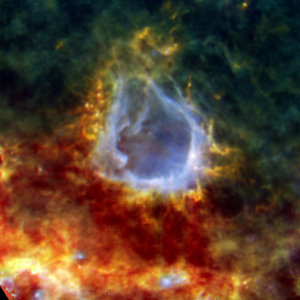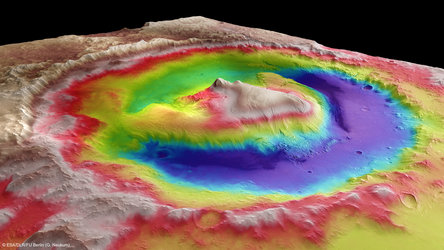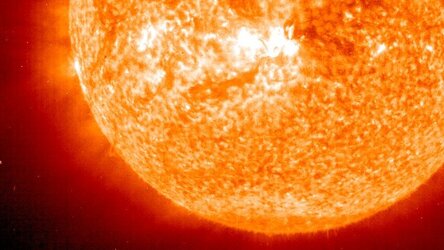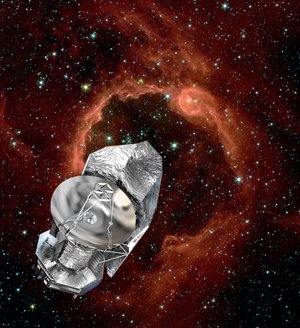A Galactic bubble with a large surprise
Nestled within the shell around this large bubble is an embryonic star that is already a hefty eight times more massive than our Sun.
This image, by ESA’s Herschel space observatory, was originally presented in the first announcement of scientific results from the mission in May 2010.
This week Herschel scientists will meet again at ESA’s ESTEC establishment in the Netherlands to present, discuss, and take stock of the scientific breakthroughs of the entire mission at The Universe Explored by Herschel symposium.
The Galactic bubble shown in this image was just one of many surprising results of the mission.
It is about 4300 light-years away and has been blown by a star at its centre. The star is not visible at these infrared wavelengths but pushes on the surrounding dust and gas with nothing more than the power of its starlight.
The pressure exerted on the surrounding material is such that it has begun collapsing into new stars.
The bright knot to the right of the base of the bubble is an unexpectedly large, embryonic star, revealed to Herschel’s infrared detectors by heating up the surrounding dense clumps of gas and dust.
Herschel’s observations have shown that it already contains at least eight times the mass of our Sun, and that it is still surrounded by an additional 2000 solar masses of gas and dust from which it can feed further.
Not all of the material will fall onto the star, however, as some will be blasted away by the intense radiation emitted by the star. Some stars reach an impressive 150 solar masses, but just how large this stellar embryo will grow remains to be seen.
This week, scientists will not only discuss star formation, but also what the Herschel space observatory has revealed about planetary system evolution, galaxy formation, the interstellar medium and more. A full programme can be found here.
Herschel was launched on 14 May 2009 and completed science observations on 29 April 2013.















 Germany
Germany
 Austria
Austria
 Belgium
Belgium
 Denmark
Denmark
 Spain
Spain
 Estonia
Estonia
 Finland
Finland
 France
France
 Greece
Greece
 Hungary
Hungary
 Ireland
Ireland
 Italy
Italy
 Luxembourg
Luxembourg
 Norway
Norway
 The Netherlands
The Netherlands
 Poland
Poland
 Portugal
Portugal
 Czechia
Czechia
 Romania
Romania
 United Kingdom
United Kingdom
 Slovenia
Slovenia
 Sweden
Sweden
 Switzerland
Switzerland

































